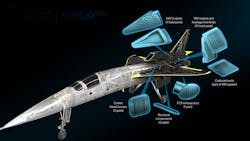3DP Ti Parts Highlight Supersonic Demo Jet
Boom Supersonic, the developer of a new, supersonic commercial aircraft, unveiled its supersonic XB-1 jet aircraft recently, which includes multiple engine and structural components produced in titanium alloys by VELO3D additive manufacturing technology.
"We strongly believe that supersonic is the future of flight and we’re appreciative of VELO3D in helping us to realize this goal with XB-1," stated Mike Jagemann, head of XB-1 production.
The XB-1 will be used to demonstrate critical technologies for Boom’s future commercial airliner, the Overture, including advanced carbon-fiber composite construction; computer-optimized, high-efficiency aerodynamics; and a supersonic propulsion system. The demonstrator is the result of several years' development, including wind-tunnel trials, structural tests, and simulations.
Last year Boom Supersonic and VELO3D established a partnership to manufacture complex components for XB-1 using VELO3D’s Sapphire laser powder bed fusion, metal-additive manufacturing system. The titanium alloys are used to form parts for engine hardware, the environmental control system, and structural components.
Some of the design features of these printed parts include tall, thin walls with high aspect ratios — elements that are difficult to manufacture with traditional processes like casting or welding, as well as most existing 3D-printing technologies. VELO3D’s "SupportFree" printing promotes design freedom and quality control, "eliminating manufacturing constraints to innovation in aircraft design," it claims.
“Aviation hardware is especially difficult to manufacture with 3D-metal printing, due to challenging aerodynamic designs that must be balanced with superior durability and high temperature requirements,” according to VELO3D founder and CEO Benny Buller. “VELO3D’s technology allows the production of lightweight, complex designs for mission-critical applications in the toughest operating conditions.”
